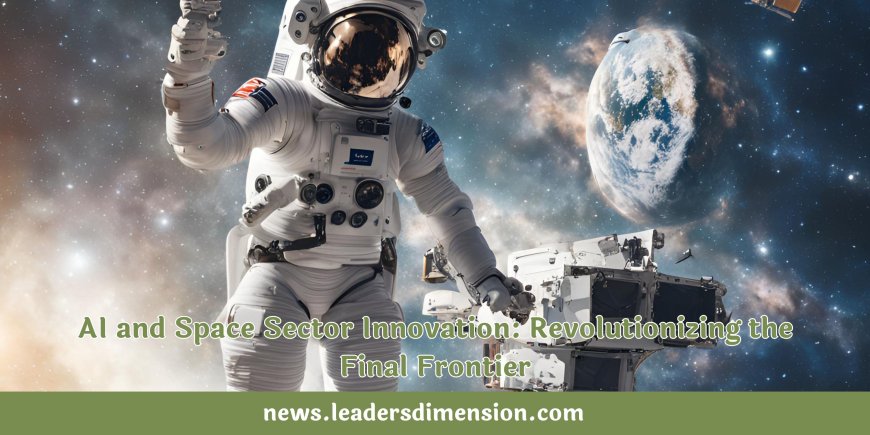AI and Space Sector Innovation: Revolutionizing the Final Frontier
Artificial intelligence is revolutionizing the space sector, enabling rapid advancements in spacecraft design, geospatial analytics, and space-based edge processing. Learn how companies like Amazon Web Services (AWS) and HawkEye 360 are leveraging AI for unprecedented innovation in space exploration and data handling.

Introduction
Artificial intelligence (AI) is propelling the space sector into a new era of innovation and efficiency. Leveraging AI technologies, companies are making significant strides in spacecraft design, geospatial analytics, and data processing. This article explores the transformative impact of AI on the space industry, focusing on key players like Amazon Web Services (AWS) and HawkEye 360. These advancements not only enhance our capabilities in space exploration but also pave the way for novel applications and services in orbit.
AI in Spacecraft Design
One of the most promising applications of AI in the space sector is in the design and manufacturing of spacecraft components. Generative AI, a subset of artificial intelligence that uses algorithms to generate new designs based on specified parameters, is revolutionizing this field. AWS, for example, is employing generative AI to create innovative spacecraft parts that are then 3D-printed and rigorously tested.
Generative AI and Rapid Prototyping
Generative AI relies on deep learning models to identify patterns and generate designs that are both highly efficient and innovative. This technology allows engineers to rapidly iterate on designs, producing prototypes that can be quickly tested and refined. The result is a significant reduction in the time and cost associated with developing new spacecraft components.
According to Alistair McLean, AWS Satellite Solutions principal architect, this approach leads to designs that are "very intuitive and very innovative at the same time." The integration of AI in the design process enables the creation of parts that may not have been conceivable through traditional design methods, thus pushing the boundaries of what is possible in spacecraft engineering (SpaceNews).
3D Printing and Testing
Once a design is generated by AI, it can be 3D-printed using advanced additive manufacturing techniques. This process not only speeds up the prototyping phase but also allows for the creation of complex geometries that are difficult to achieve with conventional manufacturing. These 3D-printed parts undergo a battery of tests to ensure they meet the stringent requirements of space missions.
The ability to rapidly prototype and test new designs is crucial for space missions, where reliability and performance are paramount. By leveraging AI and 3D printing, companies can develop high-performance components that are tailored to the specific needs of each mission, thereby enhancing the overall efficiency and success rate of space endeavors.
Enhancing Geospatial Analytics
AI is also making waves in the field of geospatial analytics, where it is used to process and interpret vast amounts of data collected by satellites. HawkEye 360, a leader in this domain, utilizes AI to identify and geolocate radio frequency (RF) emitters around the world. This capability is crucial for a variety of applications, including monitoring maritime activity, tracking illegal fishing, and ensuring national security.
Advanced Data Processing
The use of AI in geospatial analytics involves the application of machine learning algorithms and computer vision models to analyze satellite imagery and RF data. These technologies enable the automated detection and classification of objects and events, providing actionable insights with unprecedented speed and accuracy.
HawkEye 360's system, for instance, can identify specific types of RF emitters, such as X-band radars, and even attribute them to particular sources. This level of detail is achieved through the integration of AI with traditional data analysis methods, resulting in a powerful tool for geospatial intelligence (SpaceNews).
Real-World Applications
The applications of AI-driven geospatial analytics are diverse and impactful. For example, HawkEye 360's technology can be used to monitor shipping lanes and detect unauthorized activities, such as smuggling or illegal fishing. By providing real-time data on the location and movement of vessels, authorities can respond more effectively to potential threats.
In addition, AI-enhanced geospatial analytics can support environmental monitoring and disaster response. Satellites equipped with AI capabilities can quickly assess the impact of natural disasters, such as hurricanes or wildfires, and provide critical information to emergency responders. This technology can also be used to track changes in land use and monitor the health of ecosystems, contributing to more effective environmental management.
Space-Based Edge Processing
One of the most exciting developments in the space sector is the advent of space-based edge processing. This technology involves performing data processing and analysis directly in orbit, rather than transmitting raw data back to Earth for processing. The benefits of this approach include reduced latency, increased efficiency, and enhanced data security.
AWS and Space-Based Computing
AWS is at the forefront of space-based edge processing, leveraging its extensive cloud computing infrastructure to support space missions. In 2022, AWS delivered an edge computing device, the AWS Snowcone, to the International Space Station (ISS) on an Axiom Space flight. This device enables in-orbit data processing, reducing the need to transmit large volumes of data back to Earth (SpaceNews).
The AWS Snowcone has been used in a series of demonstrations with partners, showcasing the potential of space-based edge processing for various applications. For instance, in 2023, AWS and its partner SpiderOak demonstrated the OrbitSecure cybersecurity software, which facilitates secure data transmission between ground networks and low-Earth orbit.
Applications and Benefits
Space-based edge processing has numerous applications that can significantly enhance the capabilities of space missions. One key application is in Earth observation, where satellites equipped with edge computing capabilities can analyze data in real time and provide immediate insights. This is particularly useful for monitoring environmental changes, assessing disaster impacts, and conducting scientific research.
Another important application is in space exploration and crewed missions. Space-based edge processing can support medical diagnostics and emergency response in space, where immediate access to data and insights is critical. It can also be used for on-orbit maintenance and repair, enabling astronauts to troubleshoot and fix issues with minimal reliance on ground support.
The benefits of space-based edge processing extend beyond operational efficiency. By processing data in orbit, organizations can reduce the amount of data transmitted back to Earth, leading to significant cost savings and reduced bandwidth requirements. Additionally, edge processing enhances data security by minimizing the exposure of sensitive information during transmission.
The Future of AI and Space Innovation
The integration of AI in the space sector is still in its early stages, but the potential for further innovation is immense. As AI technologies continue to evolve, we can expect even more sophisticated applications and breakthroughs that will transform space exploration and related industries.
Emerging Technologies
Future advancements in AI and machine learning will enable more autonomous spacecraft operations, reducing the need for human intervention and increasing mission success rates. For example, AI-driven autonomous navigation systems can optimize flight paths and maneuver spacecraft with greater precision, enhancing the efficiency and safety of space missions.
In addition, AI will play a crucial role in the development of advanced robotics for space exploration. These robots, equipped with AI capabilities, can perform complex tasks such as building and maintaining infrastructure on the Moon or Mars, conducting scientific experiments, and assisting astronauts during missions.
Collaboration and Innovation
The continued collaboration between the space industry and AI technology providers will be key to unlocking the full potential of these innovations. Companies like AWS and HawkEye 360 are leading the way by demonstrating the practical applications of AI in space, but the involvement of other stakeholders, including government agencies, research institutions, and startups, will be essential for driving progress.
Initiatives such as public-private partnerships and international collaborations can facilitate the sharing of knowledge and resources, accelerating the development and deployment of AI-driven space technologies. These efforts will help overcome technical challenges, reduce costs, and ensure that the benefits of space innovation are realized on a global scale.
Conclusion
Artificial intelligence is undeniably transforming the space sector, bringing about rapid advancements in spacecraft design, geospatial analytics, and space-based edge processing. Companies like AWS and HawkEye 360 are at the forefront of this revolution, leveraging AI to enhance the capabilities and efficiency of space missions. As AI technologies continue to evolve, the potential for further innovation in the space sector is boundless, promising a future where space exploration and related industries reach new heights of achievement.
By embracing the transformative power of AI, the space sector can address some of its most pressing challenges and unlock new opportunities for scientific discovery, environmental monitoring, and commercial ventures. The integration of AI in space operations is not just a technological advancement; it represents a paradigm shift that will shape the future of humanity's presence in space.
References
- SpaceNews. "AI spurs space sector innovation." SpaceNews. Accessed June 27, 2024.
- European Commission. "The 2024 EU Prize for Citizens Science goes to three projects addressing marine pollution, agricultural biodiversity, and mental health." European Commission. Accessed June 27, 2024.

 LD Web Desk
LD Web Desk 